A long time ago in a garage far away a young technician was seeking a repair of a steering system. He found there are a lot of things that can go wrong with a rack and pinion steering gear. The steering wheel vibrates at speeds above 45 miles per hour; the steering wheel doesn’t return to center after a turn; the wheels shimmy when the vehicle hits a bump; no power assist; and it LEAKS.
The young technician knows that it takes many pages to describe every condition and its probable cause, and decides on a different approach. He takes as assessment of each component that makes up a hydraulic assisted rack and pinion steering gear and the failure modes that could occur. The system can be broken down into three major components: the steering column, hydraulic pump and lines, and the rack and pinion steering gear. The technician has a rack and pinion gear to repair.
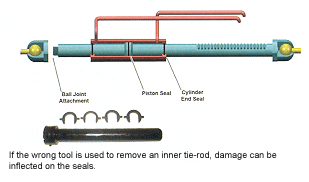 The gear is made up of four major components located in the steering gear housing – the rack and pinion gear, tie rods rotary valve and power cylinder. The rack is a straight cut linear gear. The pinion gear is set at an angle to the rack and has a helical cut. The helical pinion provides a smoother operation to the gear. The pinion drives the rack in a straight-line motion to turn the steering knuckle of the suspension. They’re very few things that can go wrong with this component. The most important part is the tension adjuster that is located below the pinion gear. There is an adjusting screw with a lock nut. Too tight and the steering wheel will not return to center. Too loose and there too much play in the steering wheel.
The gear is made up of four major components located in the steering gear housing – the rack and pinion gear, tie rods rotary valve and power cylinder. The rack is a straight cut linear gear. The pinion gear is set at an angle to the rack and has a helical cut. The helical pinion provides a smoother operation to the gear. The pinion drives the rack in a straight-line motion to turn the steering knuckle of the suspension. They’re very few things that can go wrong with this component. The most important part is the tension adjuster that is located below the pinion gear. There is an adjusting screw with a lock nut. Too tight and the steering wheel will not return to center. Too loose and there too much play in the steering wheel.
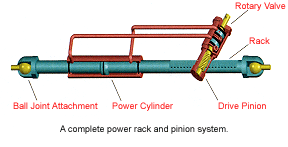 The tie rods are directly connected to the rack gear assembly. A ball joint connects the tie rod to the rack and a tire rod end, which is also a ball joint, attaches the other end to the steering knuckle. When the ball joint becomes worn or damaged, the play in the joint will cause a vibration or wheel shimmy. The ball joint has a threaded attachment to the rack. It takes a special tool to remove the ball joint from the rack without damaging a seal on the power cylinder. The passenger-side tie rod normally receives the most wear and damage because it is on the curb side where the wheel can take more hits.
The tie rods are directly connected to the rack gear assembly. A ball joint connects the tie rod to the rack and a tire rod end, which is also a ball joint, attaches the other end to the steering knuckle. When the ball joint becomes worn or damaged, the play in the joint will cause a vibration or wheel shimmy. The ball joint has a threaded attachment to the rack. It takes a special tool to remove the ball joint from the rack without damaging a seal on the power cylinder. The passenger-side tie rod normally receives the most wear and damage because it is on the curb side where the wheel can take more hits.
The rotary valve is attached to the drive pinion by a torsion bar. The torsion bar is connected to the rotary valve. The control bushing fits around the rotary valve and directs the flow of fluid to the power cylinder. The control bushing rotates with the rotary valve as the drive pinion is turned by the steering wheel.
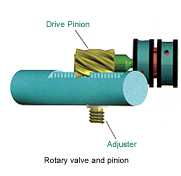 When the steering wheel is turned, the torsion bar will twist causing the rotary valve to open a return to the power steering pump. The pressure then drives the power cylinder to the left or to the right. When the steering wheel is in a straight position, the pressure is the same on both sides of the power cylinder. The control bushing must allow the rotary valve to open a return passage for fluid to return to the pump reservoir. If the control bushing rotates with the rotary valve, there is no fluid return and no power assist. In the real world, it is called morning sickness because the condition will go away after the vehicle warms up. This failure is normally caused by the seals on the control bushing wearing a grove in the housing. GM solved the problem by making the rotary valve housing out of cast iron to replace the all aluminum rack housing.
When the steering wheel is turned, the torsion bar will twist causing the rotary valve to open a return to the power steering pump. The pressure then drives the power cylinder to the left or to the right. When the steering wheel is in a straight position, the pressure is the same on both sides of the power cylinder. The control bushing must allow the rotary valve to open a return passage for fluid to return to the pump reservoir. If the control bushing rotates with the rotary valve, there is no fluid return and no power assist. In the real world, it is called morning sickness because the condition will go away after the vehicle warms up. This failure is normally caused by the seals on the control bushing wearing a grove in the housing. GM solved the problem by making the rotary valve housing out of cast iron to replace the all aluminum rack housing.
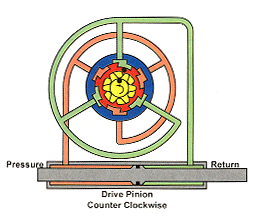 The power cylinder is a double acting piston that moves the steering knuckles through the ball joints and tie rods. The boots are the only protection for the cylinder. If the passenger side is cut or damaged to allow water and debris to enter the rack, end seal failure is soon to follow. If the drivers side is cut or damaged, the rack, pinion and adjuster wear will cause excessive play in the steering wheel. There is one other item in the power cylinder and that is the balance tube. It allows air to transfer from side to side of the rack assembly as the piston moves the rack. On most racks, the tube is internal to the housing. If the tube becomes plugged, it could cause the boot to come off of the rack housing.
The power cylinder is a double acting piston that moves the steering knuckles through the ball joints and tie rods. The boots are the only protection for the cylinder. If the passenger side is cut or damaged to allow water and debris to enter the rack, end seal failure is soon to follow. If the drivers side is cut or damaged, the rack, pinion and adjuster wear will cause excessive play in the steering wheel. There is one other item in the power cylinder and that is the balance tube. It allows air to transfer from side to side of the rack assembly as the piston moves the rack. On most racks, the tube is internal to the housing. If the tube becomes plugged, it could cause the boot to come off of the rack housing.
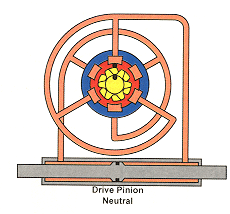 The rack and pinion gear is dependent on the engine-driven hydraulic pump and hydraulic lines. Most pump failures are caused by running out of oil. The first indication the pump is low on oil is the metallic growling noise when the steering wheel is turned. If the pump should seize, this means a lot of trouble for a serpentine belt.
The rack and pinion gear is dependent on the engine-driven hydraulic pump and hydraulic lines. Most pump failures are caused by running out of oil. The first indication the pump is low on oil is the metallic growling noise when the steering wheel is turned. If the pump should seize, this means a lot of trouble for a serpentine belt.
The most important thing to know about the steering column is that it contains an air bag. Before performing any repair on the steering column, the air bag must be disarmed. In most cases, this can be 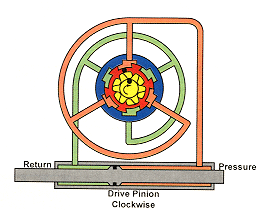 accomplished by removing the fuse that powers the system. The clock spring wiring connection for the air bag can also contain the wiring for the steering wheel controls. The air bag will always have a yellow connector. Some may have a four wire connector. This connector is for the dual stage air bags. After you have disabled the system, the next step is to disconnect the air bag.
accomplished by removing the fuse that powers the system. The clock spring wiring connection for the air bag can also contain the wiring for the steering wheel controls. The air bag will always have a yellow connector. Some may have a four wire connector. This connector is for the dual stage air bags. After you have disabled the system, the next step is to disconnect the air bag.
Some systems have a variable assist feature to compensate for the over assist at higher vehicle speeds. This can be accomplished by reducing the pressure and flow of hydraulic fluid with a solenoid-controlled valve. Other systems use a magnetic field to change to amount of effort to turn the steering wheel.
The next step is using an electric motor to provide steering assist. This type system is currently being used on the Chevrolet Malibu and Volkswagon’s New Jetta. The big feature of the electric system is no loss of assist when the engine stops. Next is to adapt the electric assist to steer by wire.












